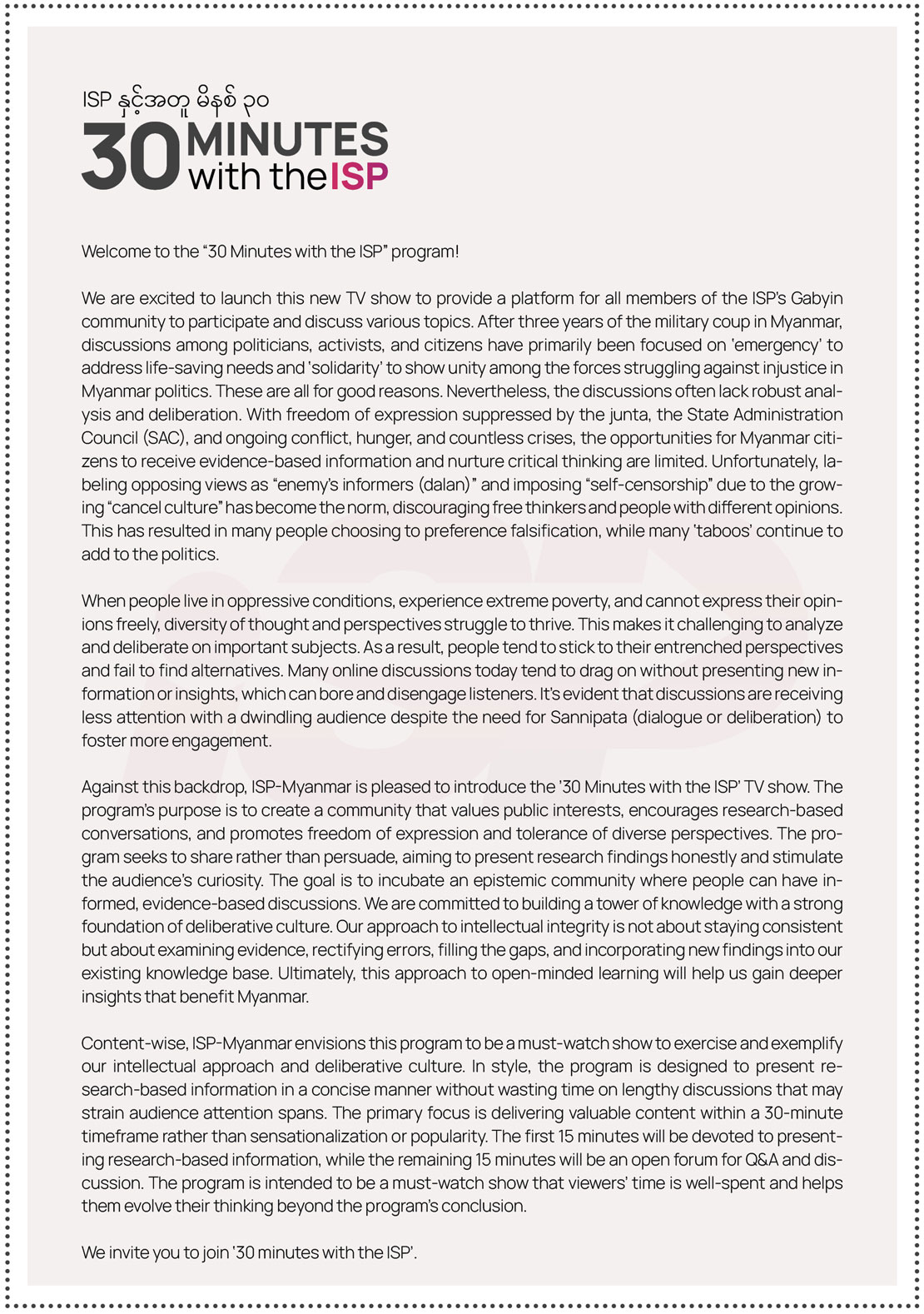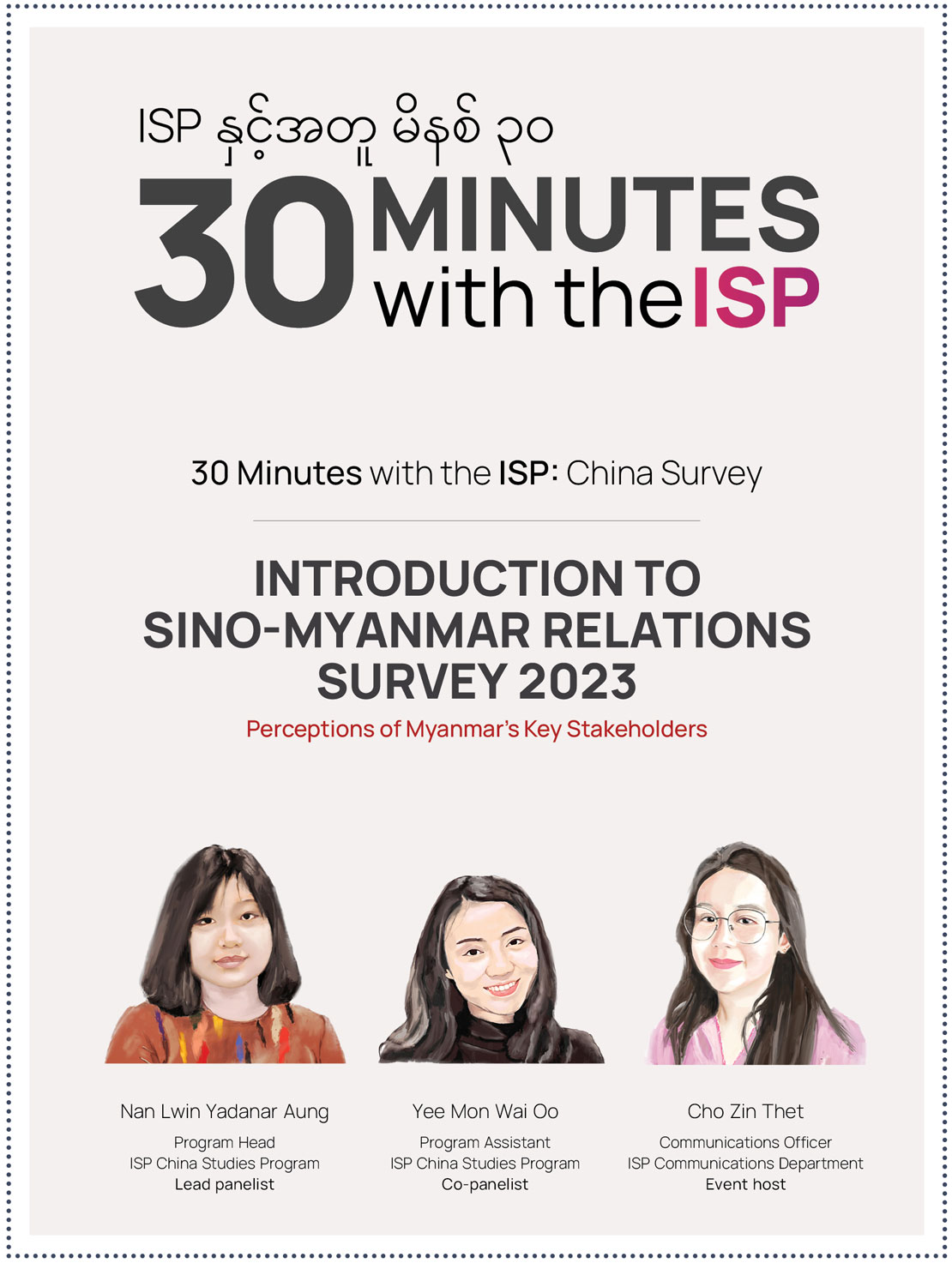

Greetings to all Gabyin members who have come to attend today’s program, 30 Minutes with the ISP. I am Cho Zin, your MC for today’s program. ISP-Myanmar will soon premiere the new talk show, 30 Minutes with the ISP.
In this program, we will address the advanced questions received from Gabyin members and attendees’ questions and comments live after the panelists have presented. We hope you can understand that questions and comments can only be up to one minute due to time limitations. As the event title suggests, we will adhere to the 30-minute limit and try to finish the program in 30 minutes. We endeavor to get some food for thought within these 30 minutes. Any further inquiries can be made through Chat or Q&A. We will answer your questions through email afterwards.
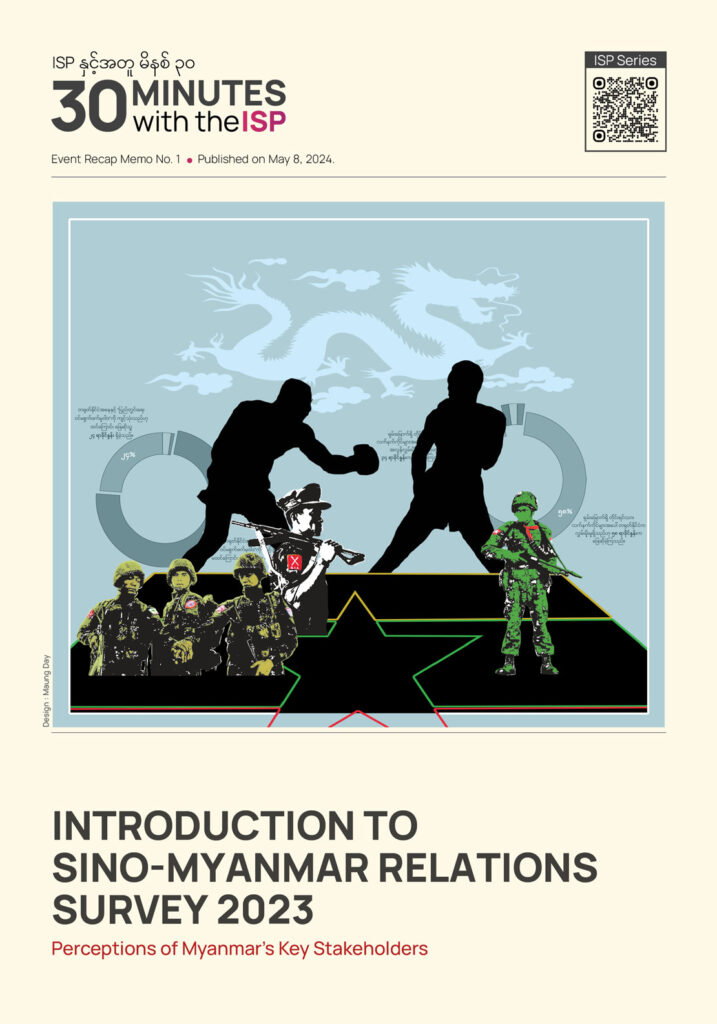
Introduction to Sino-Myanmar Relations Survey 2023
Perceptions of Myanmar’s Key Stakeholders
Please note that questions and discussions should be free of hate speech regarding race, religion, sexual orientation, or political views. The program rules have also been sent through the chat. This program will also be aired on DVB broadcasts, ISP-Myanmar websites, and social media. As the program’s debut, we would like to introduce the topic of (Introduction to) Sino-Myanmar Relations Survey 2023, Perceptions of Myanmar’s Key Stakeholders.
Our discussion today will analyze the survey brief published on April 2 on the Sino-Myanmar Relations Survey: Perceptions of Myanmar’s Key Stakeholders 2023, published by ISP-Myanmar. The China Studies’ Program Head, Miss Nan Lwin, and the Program Assistant, Miss Yee Mon will lead the discussion. Before we start the panelists’ discussion, we would like to showcase a video featuring key highlights extracted from the survey. Then, the panelists, Miss Nan Lwin and Miss Yee Mon, will take the floor.
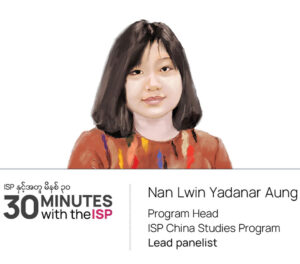
Greetings, thank you everyone who came to attend today’s 30 Minutes with the ISP Program. Today, we will discuss the key insights from Sino-Myanmar relations surveyed last year. The survey collected views of 250 stakeholders from the Myanmar policy communities on the Sino-Myanmar relations. The individuals are from six different industries and communities.
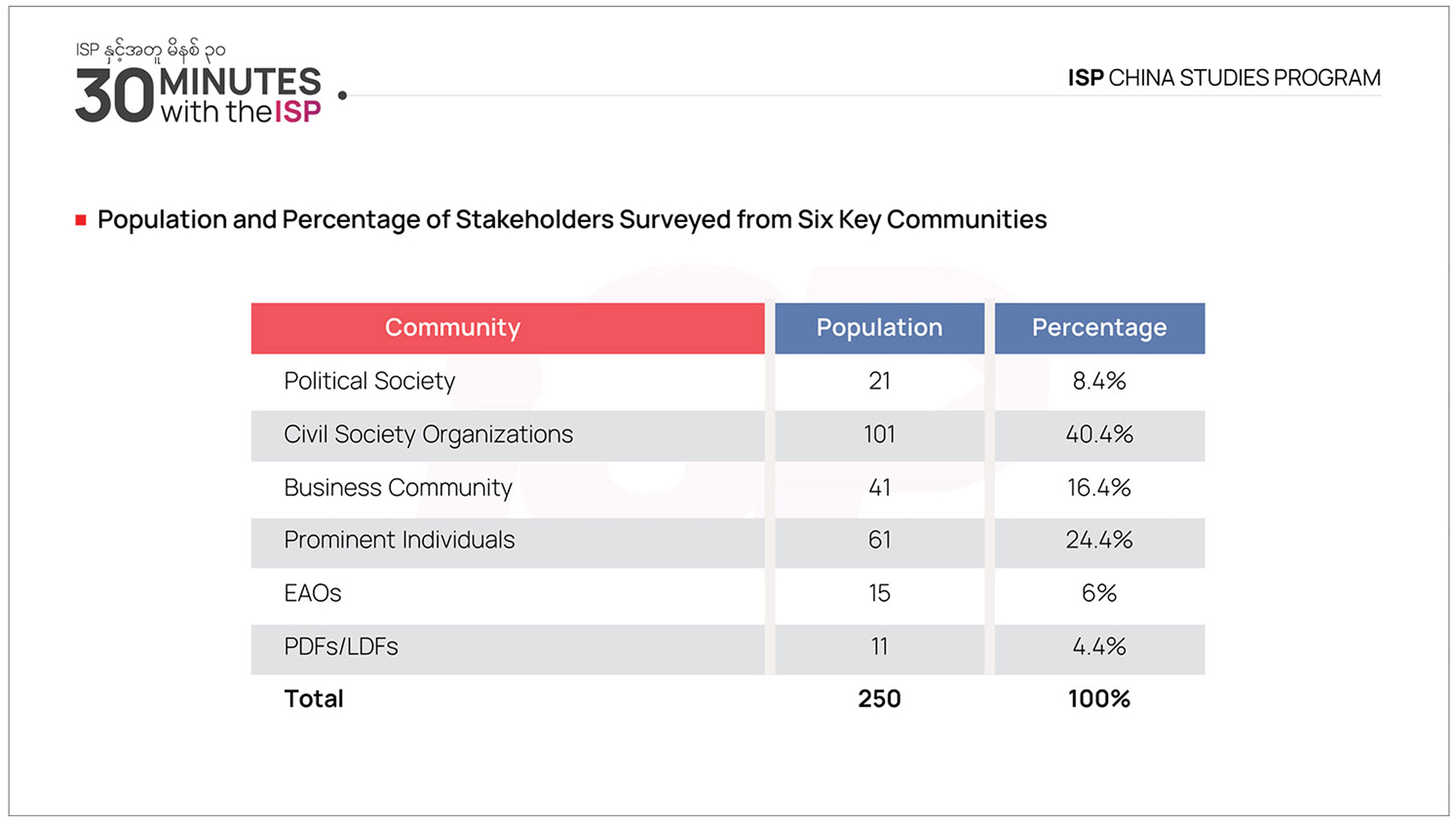
The survey aims to explore key stakeholders’ understanding and perspectives on factors shaping Sino-Myanmar relations. It also aims to provide input for policy recommendations. Today, we will delve into the survey’s key findings to understand the prevailing perceptions, any shifts in real-world conditions, and the dynamic between respondents’ perspectives and their real-life experiences. Now, to examine the findings and see if they align with reality, let’s take a look at the survey’s key findings.
As mentioned in the video earlier, 54 percent of respondents do not see China as a good neighbor, while 42 percent view it as a good neighbor. While a significant portion sees China unfavorably, many also acknowledge Myanmar’s increasing dependency on China across various sectors, including politics, peace, security, economy, and diplomacy. This makes us wonder if this is an understanding of reality.
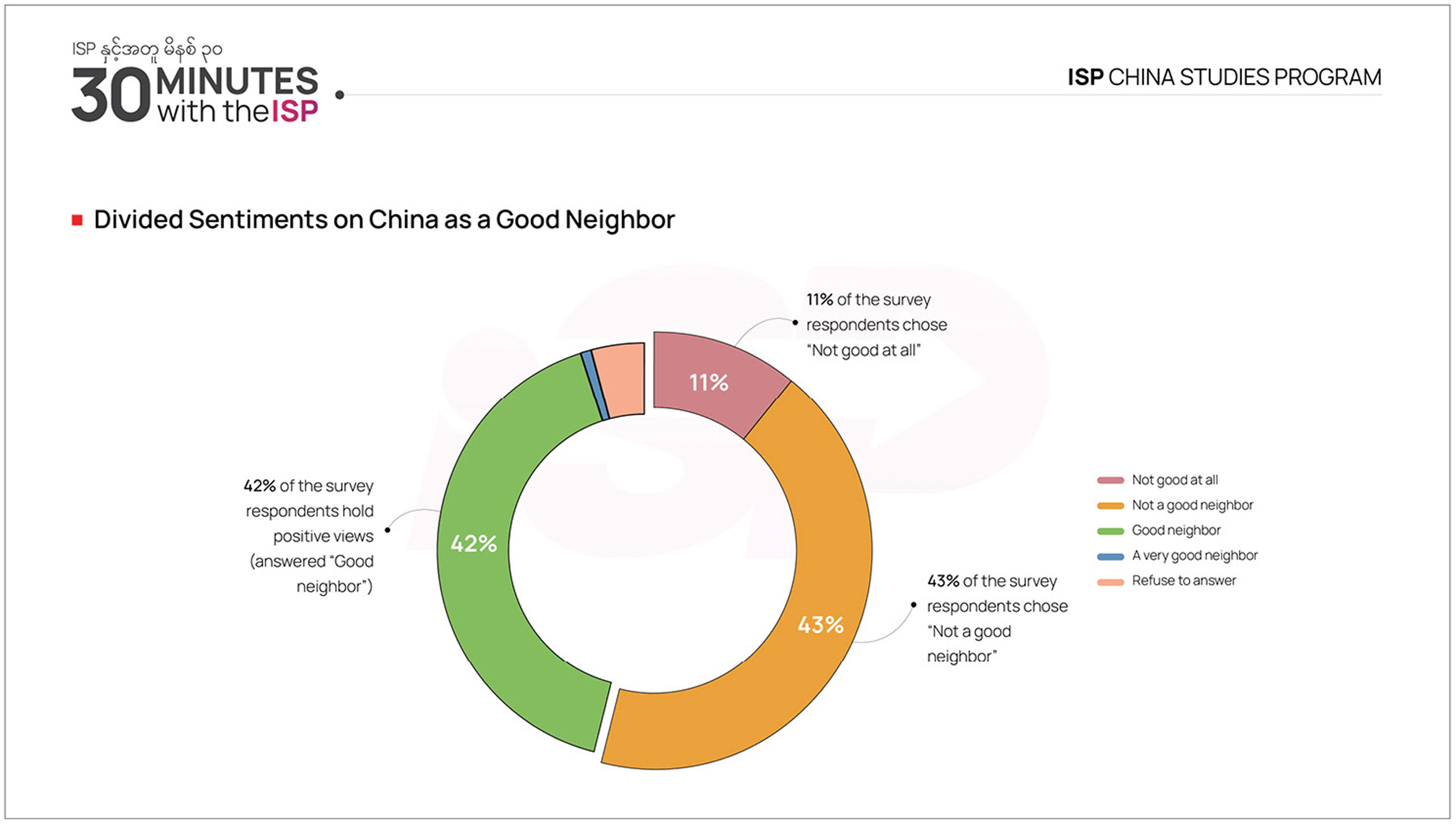
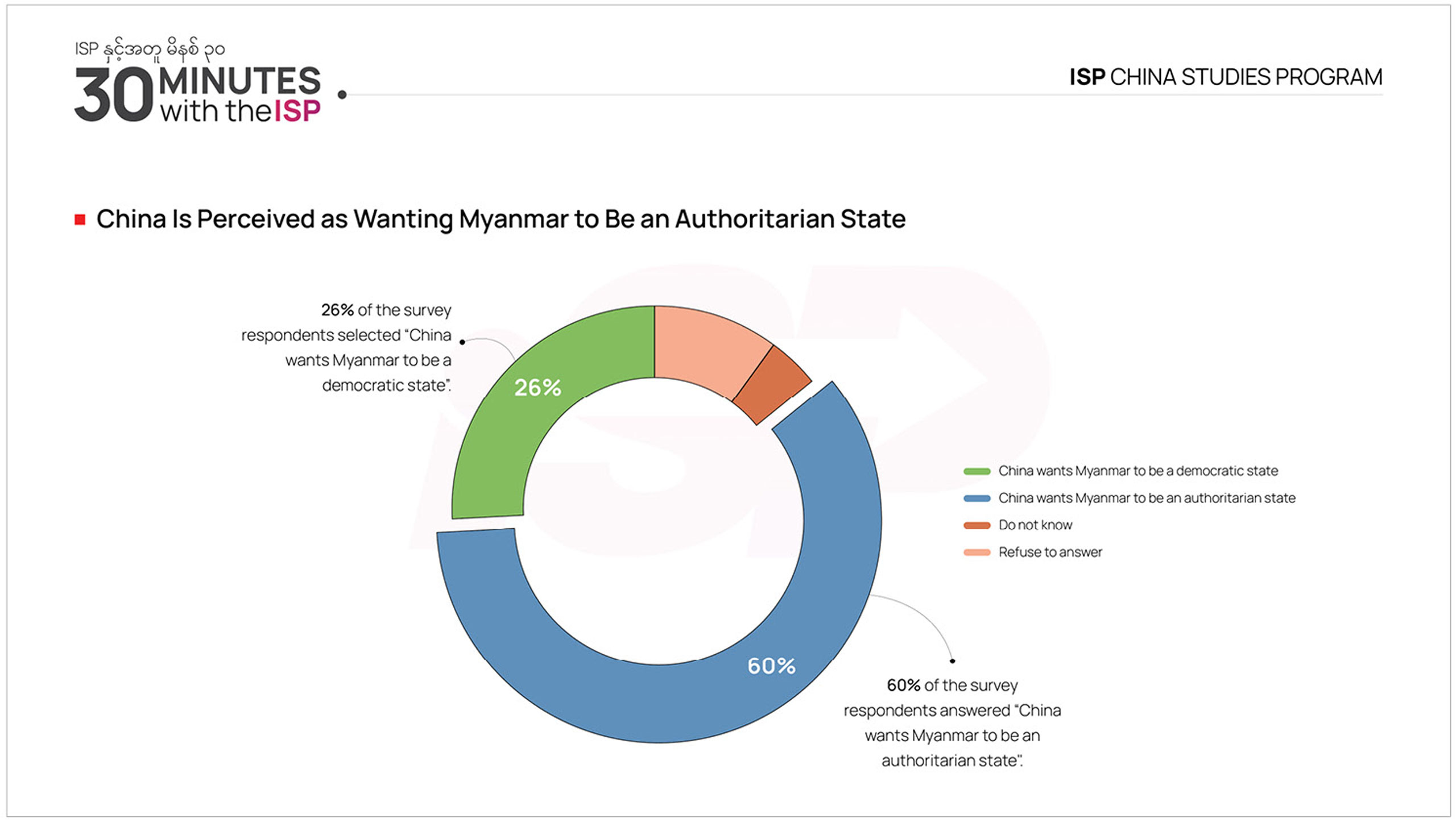
Regarding political dependency, 79 percent view Myanmar as reliant on China. 60 percent of surveyed policy communities answered that China prefers Myanmar to be an authoritarian state rather than a democratic one. Only 26 percent answered that China wants to see Myanmar as a democratic state. Although the Chinese government claims to refrain from interfering in Myanmar’s domestic affairs, 73 percent of respondents believe that China is meddling in Myanmar’s domestic affairs. In terms of the peace process, 83 percent perceived dependency on China. In terms of trade, an overwhelming 96 percent of respondents see Myanmar’s reliance on China. Additionally for the investment sector, 91 percent acknowledged dependence on China. For the technology and security sector, 70 percent of respondents perceived dependency on China.
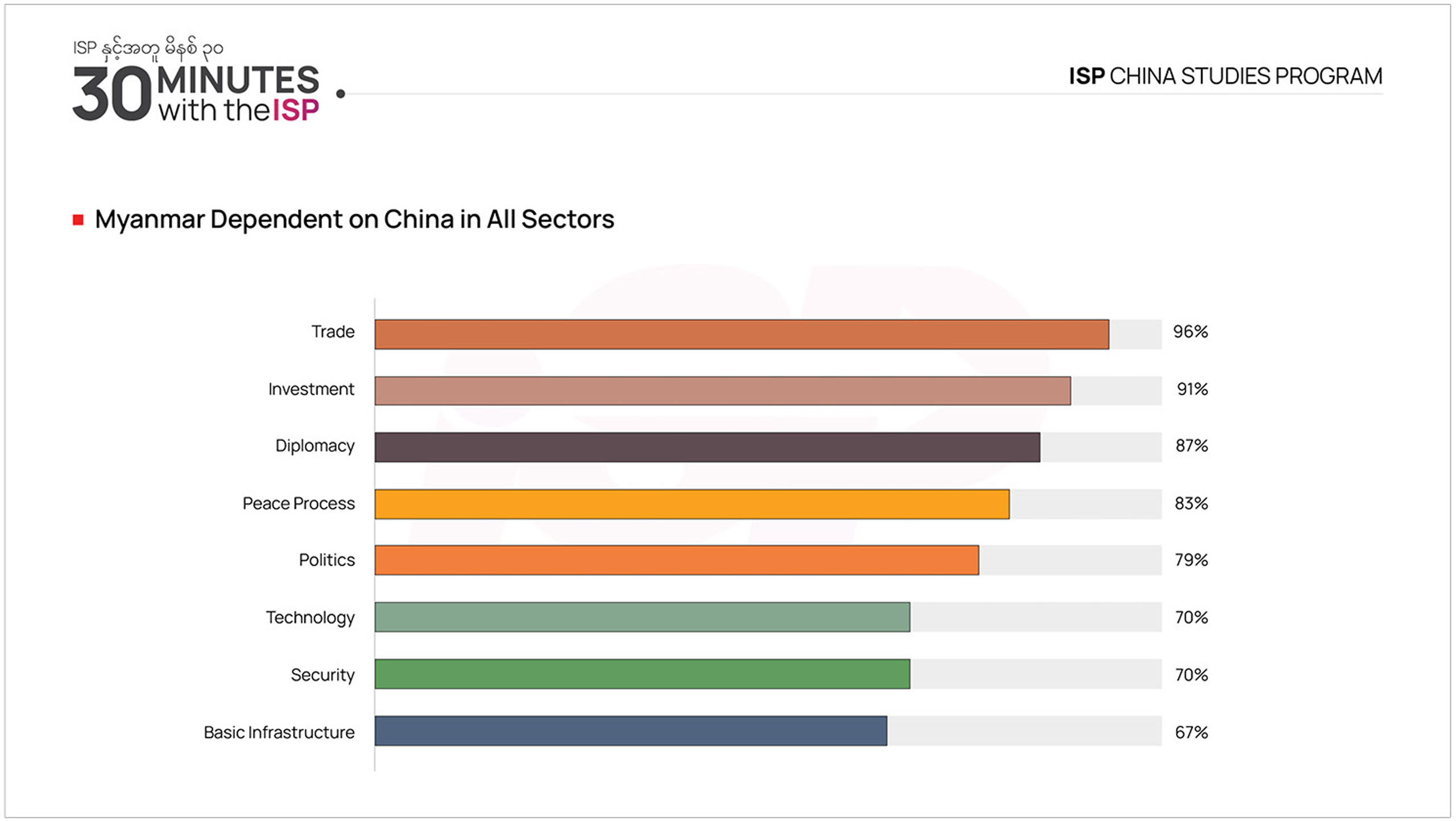
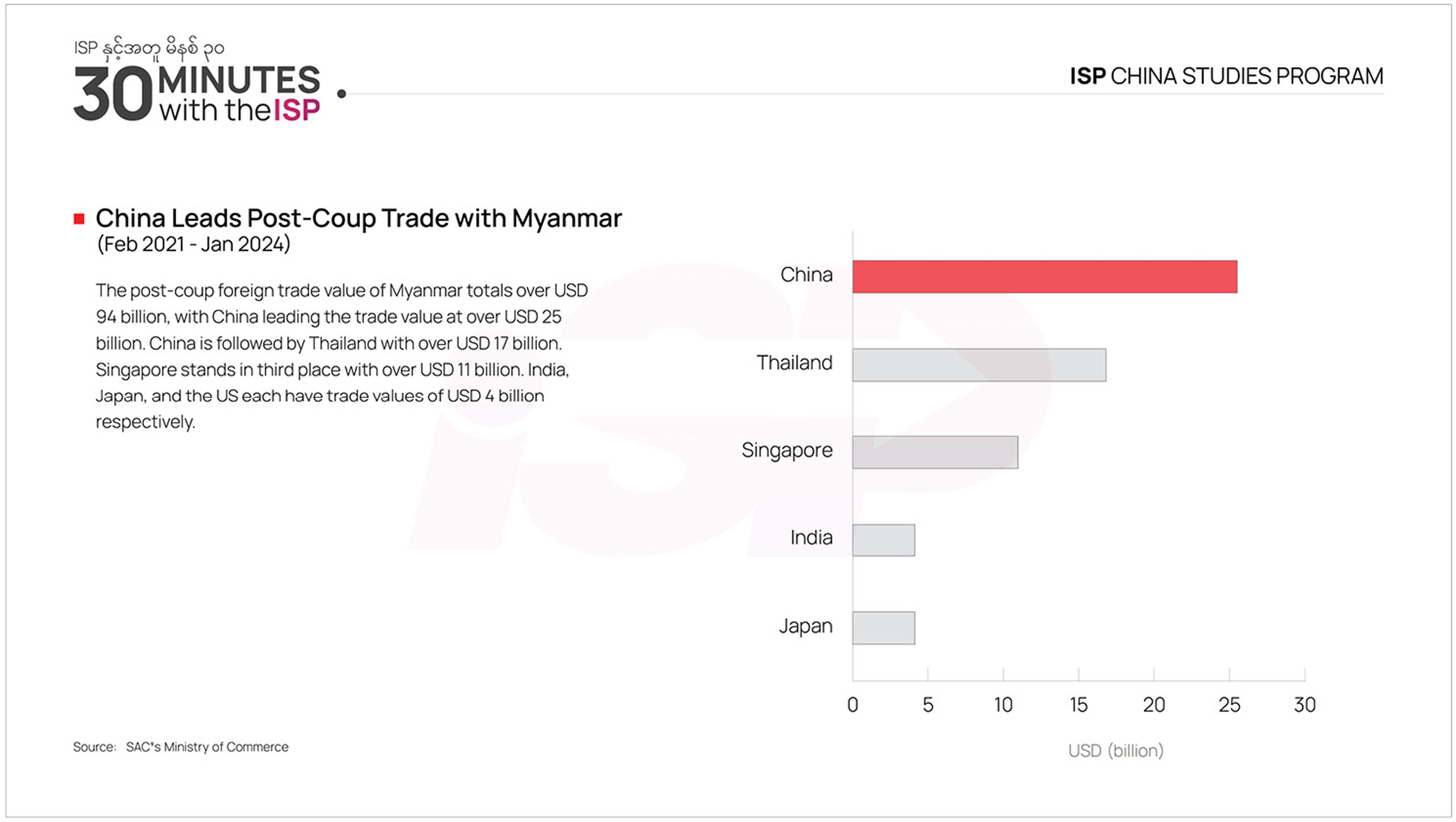
We can see that 87 percent perceived diplomatic dependency on China. When we compare it to the 2022 survey results, dependency has increased across all sectors. This could be why the survey findings indicate an increase in negative perspectives. According to the survey, respondents found it concerning that China is Myanmar’s largest economic partner. Evidently in reality, economic dependency on China has increased in the years following the coup. Most importantly, after Operation 1027, EAOs located in northern Shan State seized control over seven or more regions where China’s strategic project locations are to be implemented while five regions are partially controlled. In addition, these groups control the border trading stations, which account for 91 percent of the border trade between the two countries. Such a shift in the balance of power in northern Shan State, where most of China’s interests lie, is unlikely to happen without the spread of China’s influence.
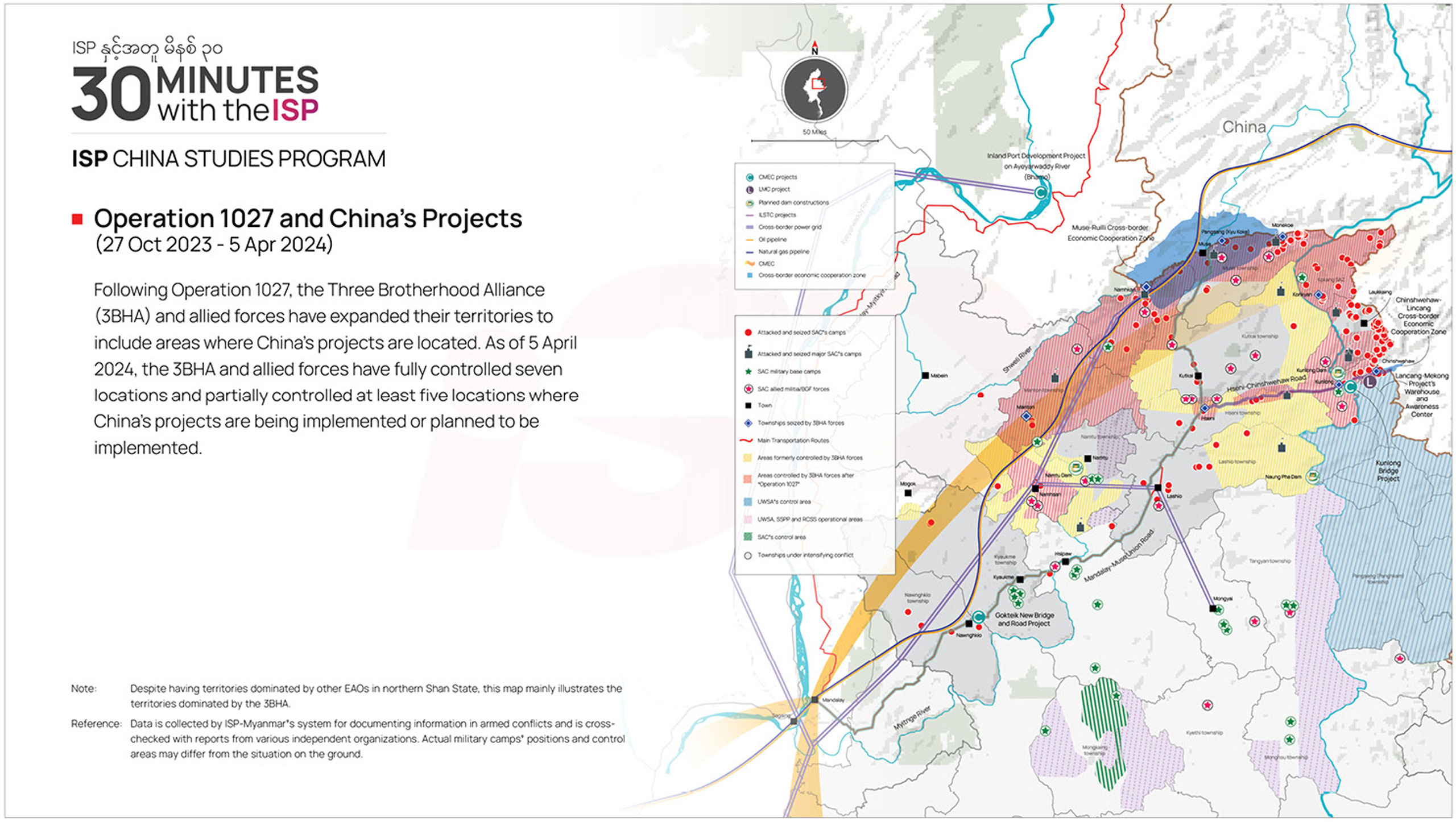
This is directly linked to China’s geopolitical thinking and strategic plans. Therefore, our survey included a section that focused on the China-Myanmar Economic Corridor. Miss Yee Mon will further discuss the findings.

Eighty percent of the respondents answered that the China-Myanmar Economic Corridor is more beneficial for China than Myanmar when asked which side it benefits better. Only one percent viewed it as more beneficial for Myanmar. Next in line, 59 percent of the respondents answered that China seeks to control geopolitically strategic locations.
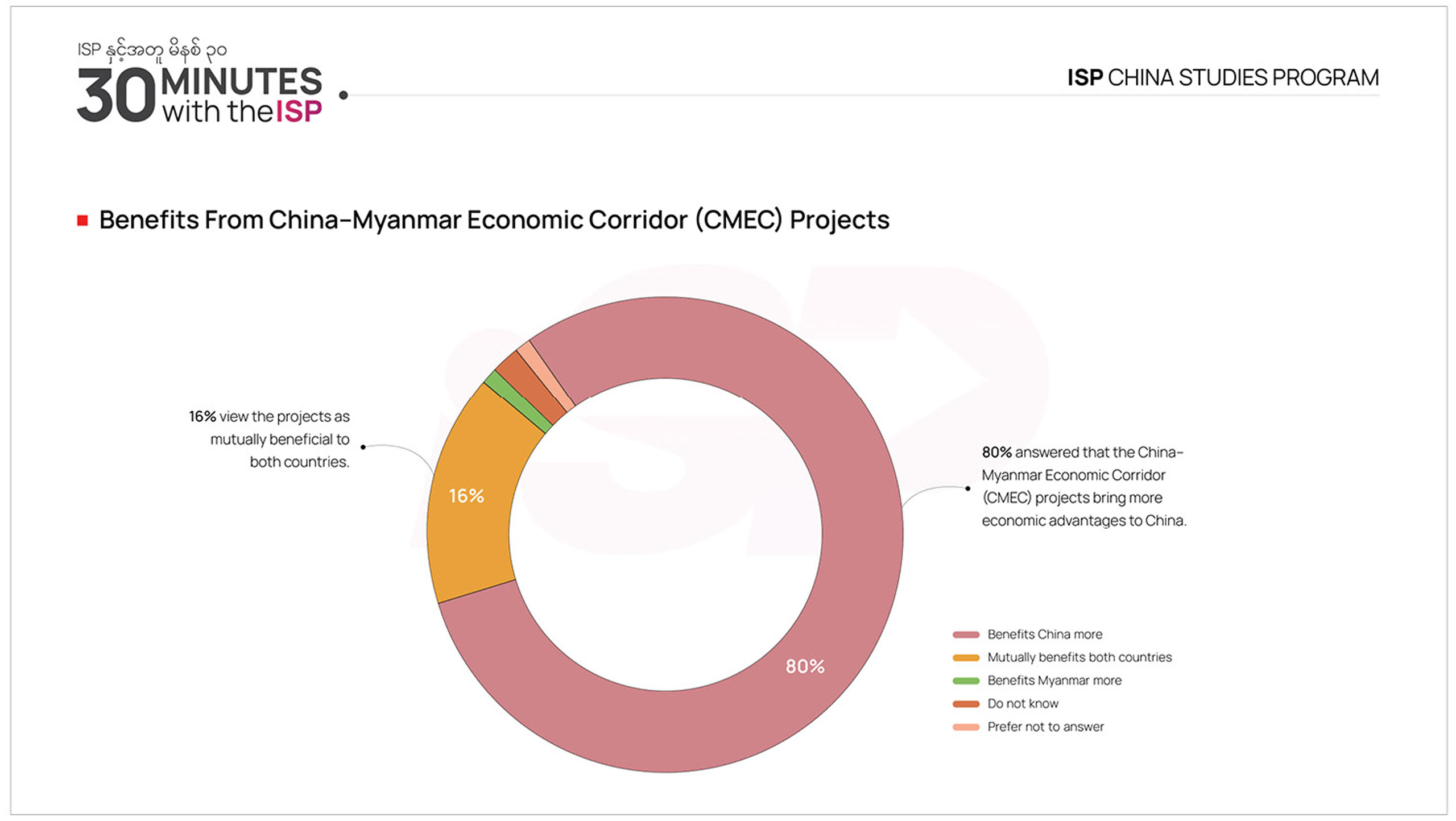

When asked about areas of concern related to the project, the majority concern was China’s growing geopolitical influence over the region. Regarding the potential impact of these projects, 67 percent of respondents answered that the projects would not likely yield a positive impact on the peace process. This answer compared to the last survey, has a notable increase. When individuals from the Myanmar policy community were asked if they had been consulted by the responsible companies regarding the projects, 81 percent responded that they had not been contacted. This finding raises questions about the transparency of economic corridor projects.
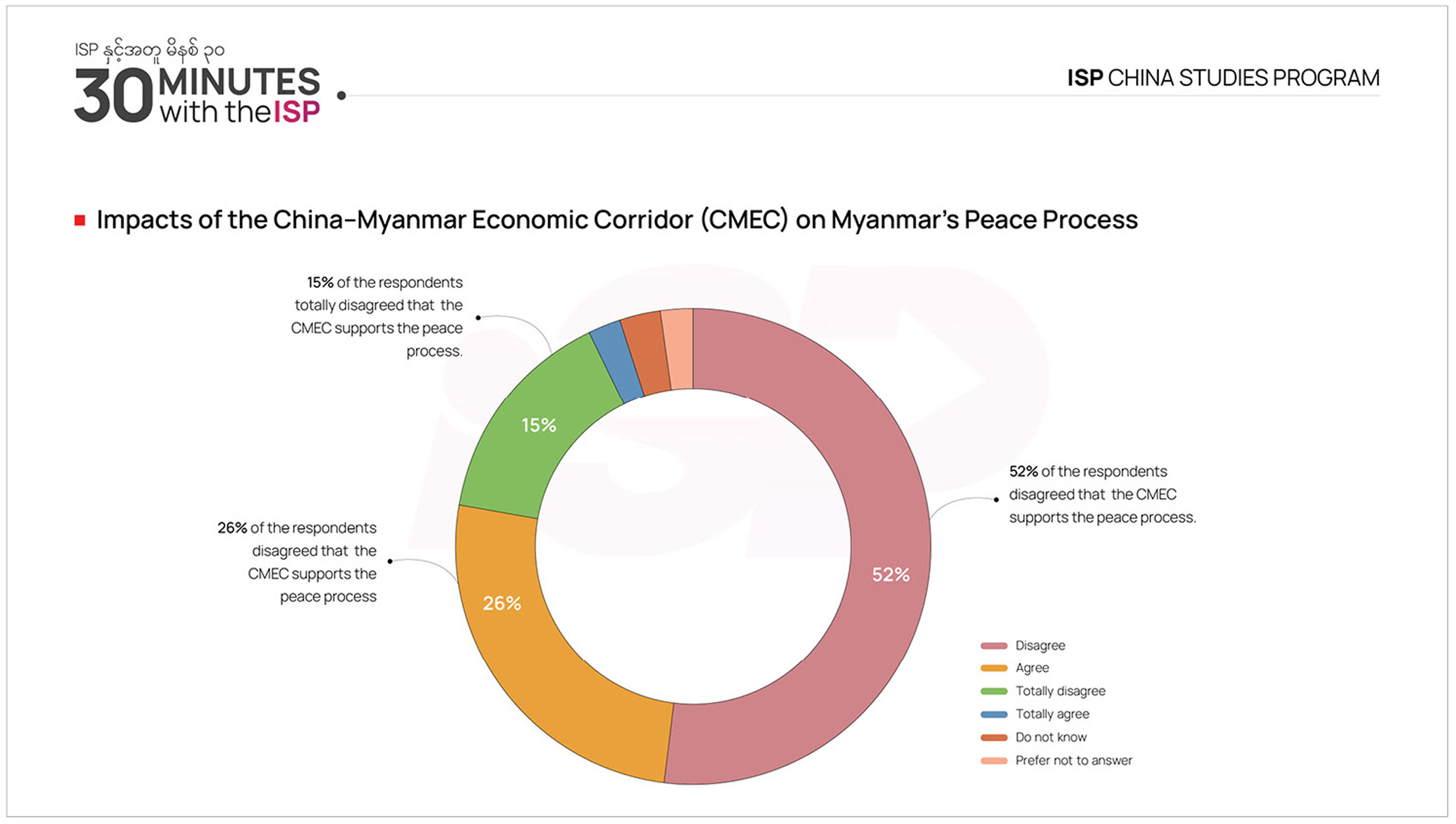
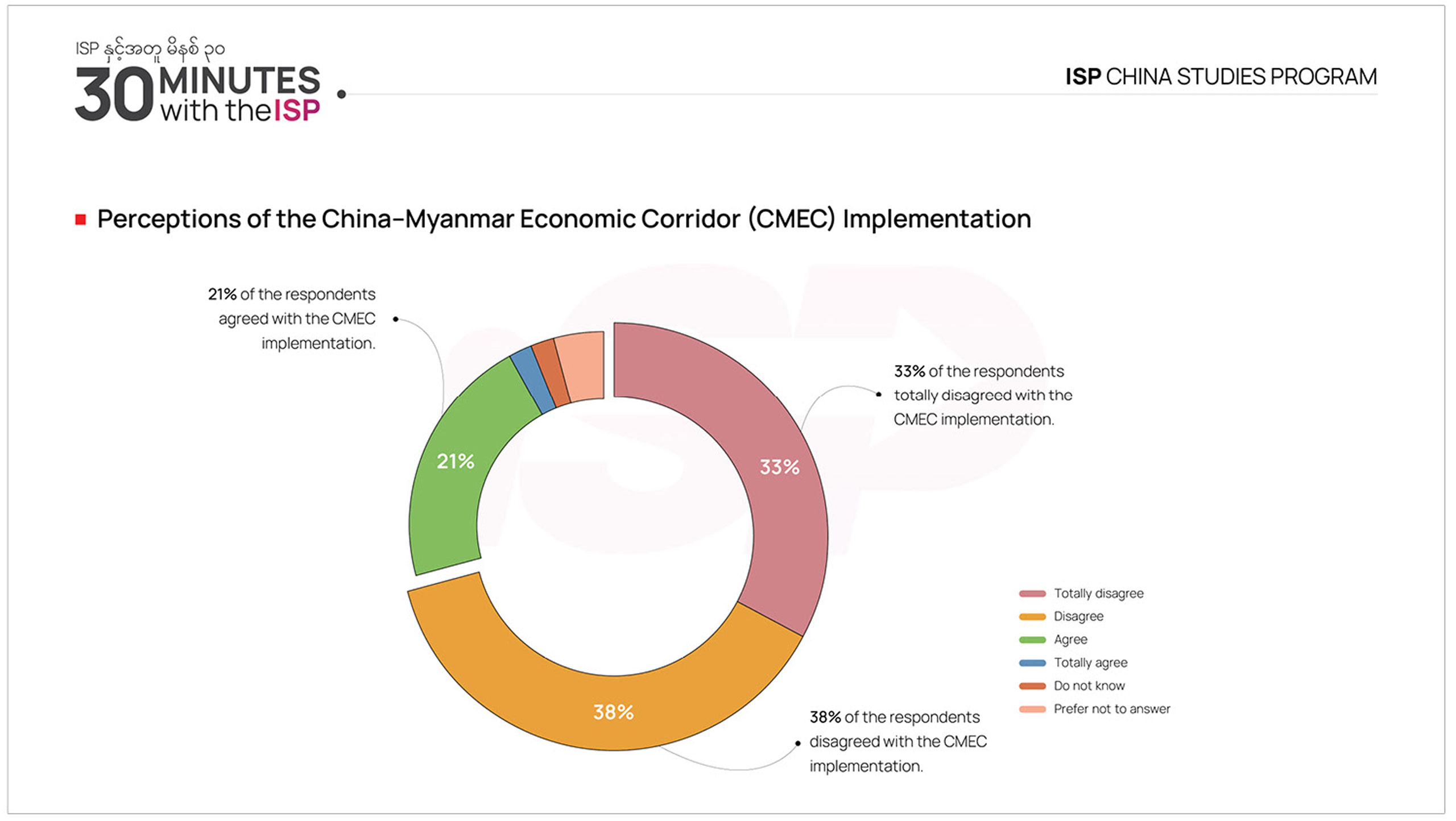
An important matter was that 71 percent of the respondents disagreed with implementing these projects amidst current political turmoil. With the predominant perception that the economic corridor projects benefit China primarily, we can reassess the credibility of the rhetoric of both countries’ authorities suggesting that the project should be mutually beneficial. Additionally, the survey revealed that over half of the Myanmar policy community is concerned that these projects represent China’s geopolitical strategy to utilize Myanmar as a land bridge and gain access to the Indian Ocean for China. Additionally, there are also disagreements and concerns regarding project implementations. Despite the concerns, both the SAC and China have actively prepared for the implementation of the China-Myanmar Economic Corridor projects. ISP-Myanmar documented 34 China-Myanmar economic corridor projects that were initially slated for implementation before the coup.
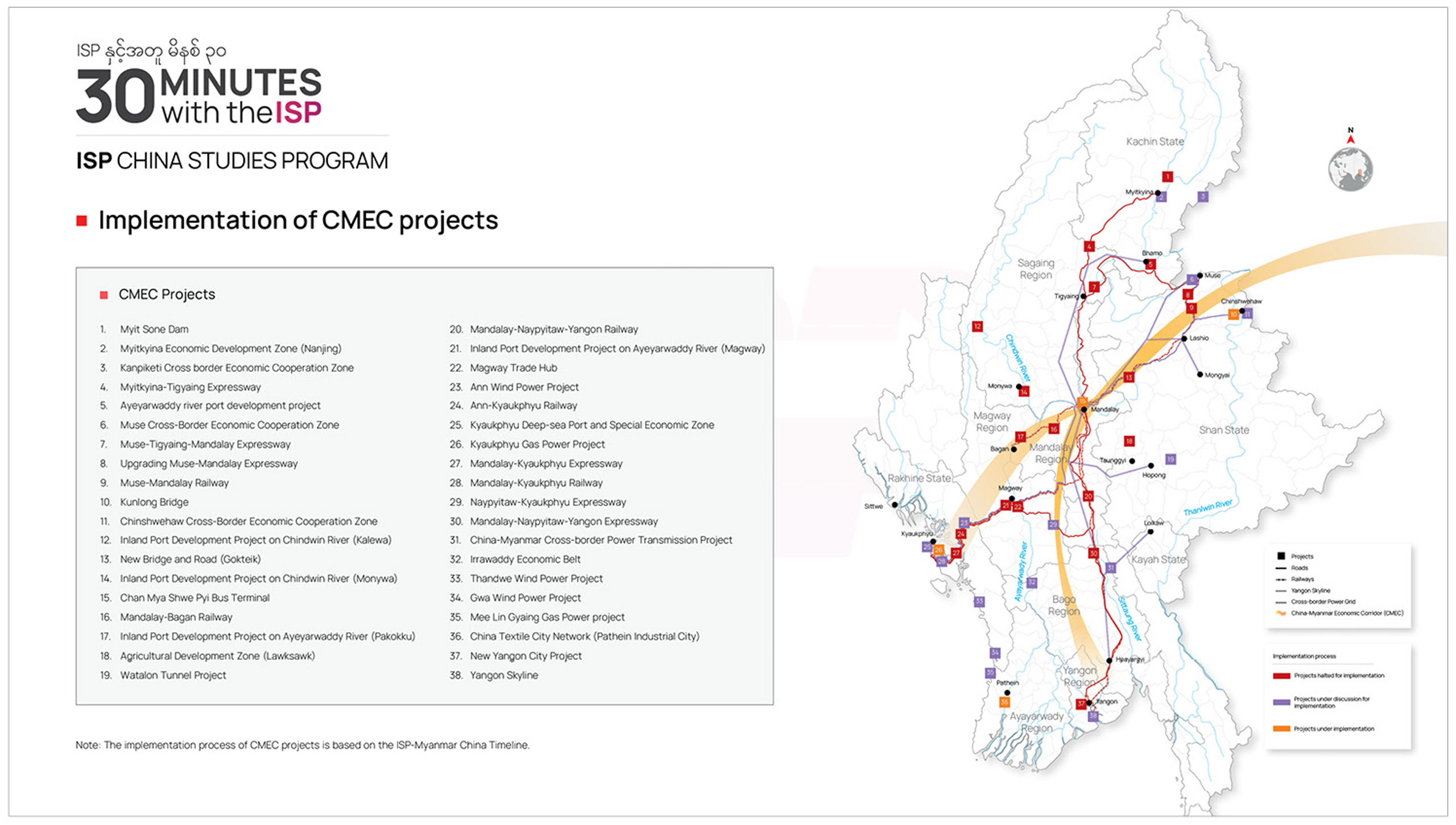
Following the coup, the number of projects expanded by four, including wind power and rail expansion initiatives, resulting in a total of 38 projects. After the coup, China has made great efforts in the regional integration plan through Myanmar. Miss Nan Lwin, could you please discuss further details about the survey findings regarding this matter?

In the past three years, China has been emphasizing a regional integration plan in Myanmar. However, our survey findings revealed that awareness of these significant projects implemented by China in Myanmar remains low, even among members of the Myanmar key stakeholders. Allow me to provide some examples of these findings. According to the survey findings, the Global Security Initiative (GSI), which also enables security cooperation between the two countries, is not known among 74 percent of the respondents. Interestingly, 80 percent of the EAOs are unaware of the GSI. The GSI is an initiative prioritized by China’s President, Mr. Xi Jinping, during his presidential reign to establish security cooperation with regional countries. As part of the initiative, China plans to provide up to 5,000 training sessions to promote the rule of law over the next five years. This training will enable countries in the Mekong region, including Myanmar, to adopt China’s security methods. The training is also being started now in Myanmar. Furthermore, under the GSI policy, the SAC will receive heightened diplomatic protection from China on the international stage, and security cooperation between the two nations will intensify. Consequently, the SAC has issued a statement welcoming the GSI.
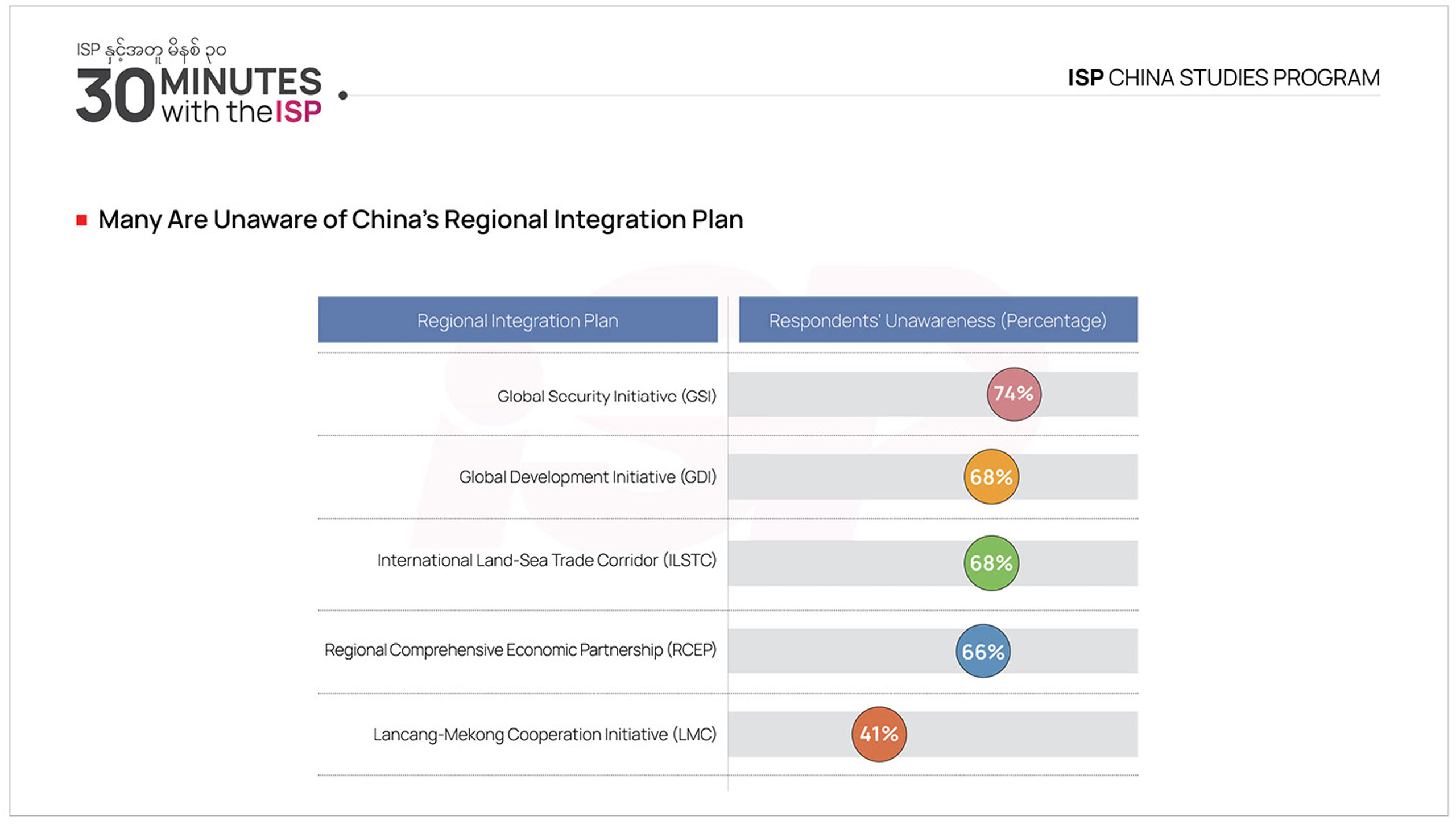
Conversely, 41 percent of respondents are unaware of the Lancang-Mekong Cooperation (LMC) initiative. It aims to foster collaboration among Mekong countries in political, economic, and security domains. In reality, the implementation of the GSI is intricately connected with the LMC. Both initiatives hold significance for China’s regional influence, particularly as the Mekong region is situated in the center of the Indo-Pacific, a crucial area of tension between the United States and China. Furthermore, unconventional security cooperation is underway within the Lancang-Mekong Cooperation (LMC) framework, including efforts to combat Kyar Phyant (cybercrime syndicates).
Additionally, efforts are emphasized to implement cross-border business cooperation, transportation routes, and ports. These projects have been swiftly implemented over the past three years, spanning various sectors from security to economy. Regardless of Myanmar’s policy community’s stance towards China, it appears that Myanmar has become deeply entrenched within China’s sphere of influence, unable to easily extricate itself from this dynamic. Meanwhile, Myanmar, beset by conflicts and crises, may not fully reap the benefits of these initiatives and may lag behind compared to other member countries. It’s imperative to exercise caution regarding contracts lacking transparency under these plans, as they could become contentious in the event of a change in government in the future.
As discussed, the policy community’s lack of awareness is evident in its unpreparedness to anticipate the potential implications and safeguard national interests from these initiatives. The gap is even wider for those who will directly experience the impact. Hence, the public can’t avoid accepting these initiatives without adequate time to prepare and comprehend their pros and cons. On the one hand, there’s an analysis of how the Myanmar policy community perceives China’s development models, suggesting an inability to break free from China’s cycle of economic and political influence through cross-border initiatives. Miss Yee Mon will further discuss this matter.

Indeed, according to our survey results, 87 percent of the Myanmar policy community disagreed with the implementation of democracy with China’s characteristics. The government of China, under the complete control of the Chinese Communist Party, frequently refers to its parliamentary-like congress meetings, attended by party representatives, as China’s version of “people’s democracy.”
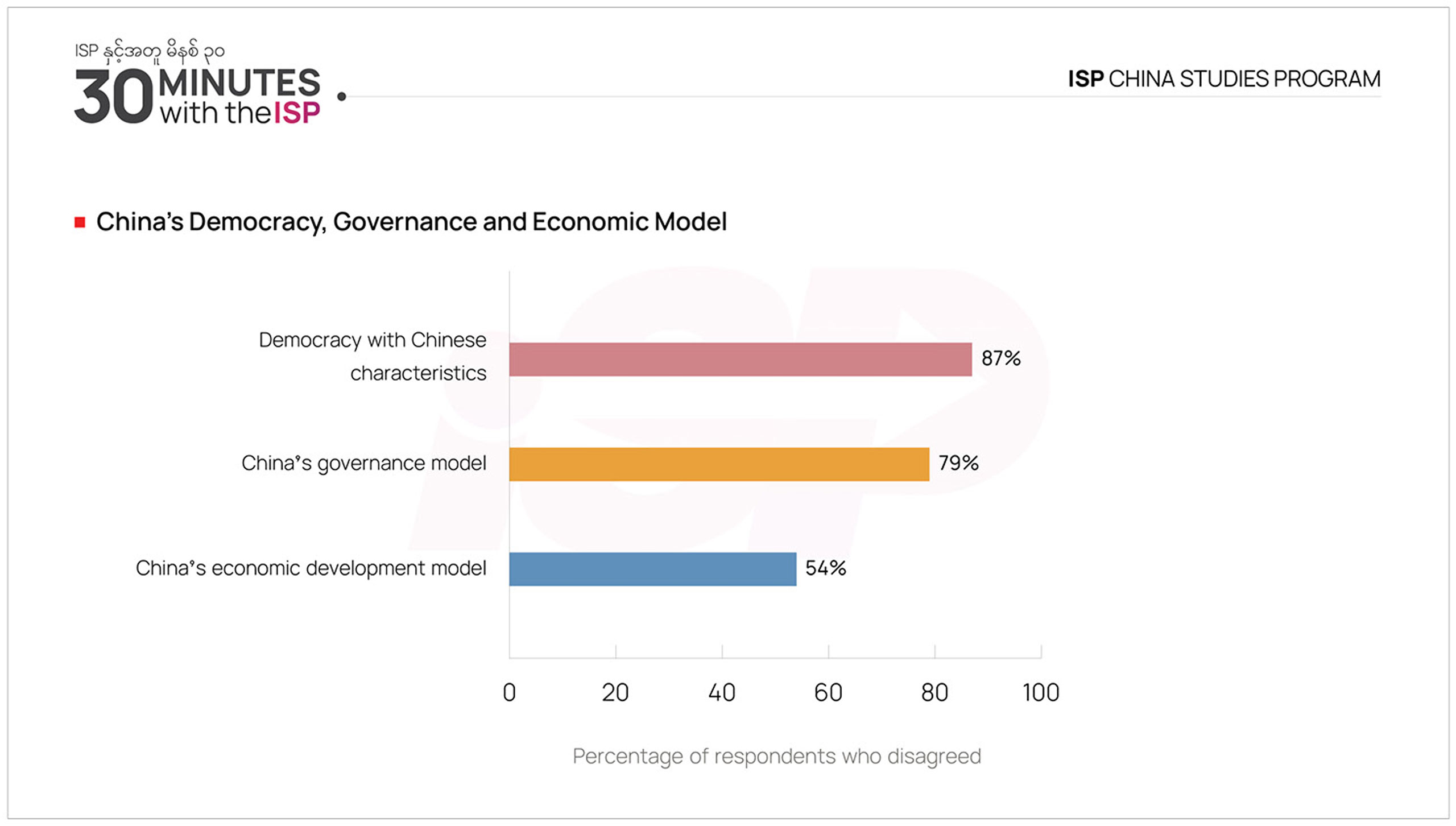
When asked about the Chinese governance model, 79 percent disagreed that it was an ideal model to follow. Additionally, 54 percent of the Myanmar policy community also answered that the Chinese economic development model is not an ideal model to follow. This observation highlights China’s efforts to export its governance and economic development models in Myanmar through soft power over the past decade, but it’s notable that these efforts have not significantly influenced Myanmar’s policy community. Particularly striking is the lack of enthusiasm among more than half of Myanmar’s policy community regarding the developmental progress witnessed in neighboring China. What’s particularly noteworthy is the unanimous stance among all EAOs, expressing disagreement with the implementation of Chinese governance and democracy in Myanmar. Would you like to comment any further as a conclusion Miss Nan Lwin?

Today’s presentation summarized insights based on survey findings of Myanmar’s dependence on China in sectors such as politics, peace, economy, the CMEC economic corridor, and perspectives on China’s regional initiatives through Myanmar and models of democracy and economic development with China’s characteristics. I would like to emphasize that China-Myanmar relations need to be studied more. Based on these types of surveys, we invite widespread critiques and discussions. I encourage this. Sino-Myanmar relations hold significant importance for Myanmar, influencing everything from the sovereignty of a country and the process of nation-building to its economic development. In our examination and assessment of the Sino-Myanmar relationship, but rather to advance the national interests of both countries. We should approach this issue to enhance understanding and foster mutual affection between the citizens of both countries. For this reason, at ISP, we are committed to delving deeper into our comprehension of China-Myanmar relations. I would like to conclude by welcoming interested parties to engage in discussions and offer suggestions on this matter.

Thank you, Miss Nan Lwin and Miss Yee Mon for discussing the matter. I would like to continue to Q&A session. The panelists will discuss and answer the questions sent in advance via email by Gabyin members attending the discussion. Three similar questions have been combined and prepared.
The first question is that the National Unity Government (NUG) issued a policy regarding China. How do you see the NUG’s relation with China and NUG’s China policy?

As far as I’ve analyzed, since China stopped supporting the Communist Party of Burma (CPB), it has almost ceased to provide direct support to the domestic opposition. They directly engage with anyone who holds the central state power. On the other hand, there has been a series of relations and aids, what we call Frontier Management, among the ethnicities living at their borders for border management, stability, and interests. This is notable because China strategically cultivated relationships with the National League for Democracy (NLD), led by Aung San Suu Kyi, prior to its assumption of government power. China views Daw Aung San Suu Kyi as having skillfully managed China relations and favored her country’s interests rather than being inclined toward the West. China fostered strong ties, particularly by believing that she was a leader who wouldn’t undermine China’s interests. Thus, China felt all its efforts went to waste after the coup and was really disappointed. We observe that China does not consider the NUG as a direct continuation of the NLD party government previously led by Aung San Suu Kyi. Additionally, China sees the NUG to be more inclined towards the West. On the other hand, China also only sees the NUG as an opposition in the transition period. In particular, we can see that the newly emerging opposition is not seen as a national-level alternative. Until something happens on the ground that changes this point of view, we can only expect that China and NUG’s relations will likely be on an ad hoc basis.

Thank you very much for answering Miss Nan Lwin.
As for the second question, what is China’s position after the Operation 1027, launched by the Three Brotherhood Alliance in the northern Shan?

We can see that there has been a shift in the power balance within the FPNCC alliance group led by the Wa Army and in northern Shan. Among the formidable armed forces engaged in this, an assumption appears that neighboring countries will respect you only if you are fighting and if you get victory. Thus, we observe many groups have initiated military efforts to balance the power. In Operation 1027, it is observed that China attempts to stop the conflict at its border and to restore stability energetically. China has emerged as an indispensable player in mediating Myanmar’s conflict. Yet, we must acknowledge that the leaders of EAOs are not mere proxies of China; they have their own agencies and autonomy to navigate their struggles. It should be noted that the actors in Myanmar are not the objects of China and will not always follow along with China. However China’s approach is solely focused on achieving negative peace, such as short-term ceasefires and stability, aimed at restoring central power once stability is attained. Regardless of the extent of short-term ceasefires, if the underlying political issues and nation-building remain unresolved, the cycle of conflict will inevitably recur, affecting all parties involved not to break out from the circle. This serves as a cautionary reminder.

Thank you, Miss Yee Mon, for your answer. The third question is how would China’s government respond regarding America’s Burma Act, where 121 Million USD has been announced to provide in support of Myanmar’s democracy.

Indeed, following the coup, it is evident that China has constrained Myanmar’s political maneuverability within its sphere of influence, effectively limiting international intervention in the Myanmar crisis. China has been extending its influence on Myanmar’s internal security by engaging with ethnic armed groups aligned with its interests through various transnational measures. We can also see that China uses neighborhood diplomacy in terms of Myanmar’s crisis solution, by not dealing with the problem source and only reducing short-term conflict, just as discussed by Miss Yee Mon. China’s neighborhood diplomacy effectively sidelines ASEAN, rendering its role ineffective, and subsequently prevents the involvement of Western nations, particularly the United States, in Myanmar’s affairs. However, there is also the potential support from the United States through initiatives like the Burma Act. As a vulnerable and war-torn nation, it’s crucial for us to navigate carefully to avoid becoming a battleground in the rivalry between these two major powers.

Thank you, Miss Nan Lwin.We will now take one question and remark each from our Gabyin member attendees. Those who want to question or make a remark can raise hand. We will invite the first two attendees who have raised their hands.

I would like to ask one question. You mentioned earlier that the Three Brotherhood Alliances have seized over five strategic areas through Operation 1027. On the other hand, China has control over the revolutionary organizations. Additionally, top officers of China came to visit the former Junta, Than Shwe, a few days ago. Regarding this matter, could there be any power struggles between the NUG and the Ethnic Armed Organizations? How would ISP remark on China’s position in this matter? I would like to ask this question.

Thank you for your question. The current situation is as mentioned before in the discussion. China became an important actor for Myanmar following Operation 1027. In terms of conflict resolution. Hence, when we look between the NUG and the EAOs, the EAOs tend to consider their interests primarily. As we consider the trajectory, it’s conceivable that the relationship between China and EAOs will evolve based on the strategic plans and interests of the EAOs themselves. So, looking back at the EAOs, they will decide after considering their own interests.

We would like to invite the second speaker who has raised hand. Yes. Since we have no comments currently, we would like to conclude our program here. Are there any further comments from the panelists?

Based on our discussion and survey findings, it’s imperative to advance China-Myanmar national interests, such as policy considerations and strategies for fostering mutual understanding between the people of China and Myanmar. I would like to conclude this discussion by strongly urging again that we need to emphasize bringing these out.

I would like to conclude the show by thanking the Gabyin members for attending the premier of 30 minutes with the ISP.
Appendix
This appendix includes responses to the questions which we could not answer during the event. These are the questions we collected in advance of the event and the questions received via chat and Q&A buttons during the event.
What definition did the respondents use to provide opinions on “Democracy with Chinese characteristics”? In other words, how did the respondents understand “Democracy with Chinese characteristics”?
As discussed during the “30 Minutes With the ISP” event, the Chinese government is fully controlled by the Chinese Communist Party (CCP), and the CCP’s National Congress meetings are held in the form of parliamentary meetings. The Chinese government refers to this as people’s “Democracy with Chinese characteristics”.
How do you think China will respond to the investment policy announced recently by the ULA/AA? Can China’s response shift the relations orientation between the SAC and China?
China focuses on border stability, security, and the protection of its interests in its relations with non-state actors in Myanmar, especially ethnic armed organizations near the China-Myanmar border. In Rakhine State, there are strategic projects such as the Kyaukpyu deep-water sea port and the China-Myanmar oil and gas pipelines, which provide China access to the Indian Ocean and enhance its geopolitical influence. These interests have also driven China’s involvement in negotiating the Rohingya crisis. China has become more pragmatic in its relations with Myanmar. The larger the territories controlled by the Arakan Army (AA) in Rakhine State and its influence over China’s strategic projects, the more likely a shift in the orientation of China’s relations with the SAC. Instead of immediately responding to these changes, China is likely to adopt a wait-and-see approach to decide how to implement its long-term strategy and determine which steps will best protect its interests.
This balanced approach is suitable for the mutual interests of both countries. However, China can be seen as focusing only on the protection of its own interests. What negotiations will it take to achieve balanced relations with China?
Regarding the foreign policies of powerful countries like China, it is a fact that they will prioritize their national and strategic interests. For Myanmar, a weakened country suffering from conflict, the first consideration should be to avoid becoming a victim of geopolitical rivalries between powerful nations. Secondly, as discussed in the “30 Mins with the ISP” event, China-Myanmar relations can impact Myanmar’s sovereignty, building of a federal union, and Myanmar’s economic development. In analyzing China-Myanmar relations, it is necessary to consider policy measures and processes that promote the national interests of both countries and foster good relations between their citizens, rather than adopting an anti-China perspective. Everyone should work together towards this goal. Thirdly, Myanmar needs to reach a state where it has the capacity to negotiate with China for mutual benefits.
Since China has become an authoritarian state, it seems like it may have oppressed its citizens, and the rights and wages of workers and farmers. So, China might worry that democracy in Myanmar might lead to people’s uprisings in China. So, I think China does not want a flourishing democracy in Myanmar and instead it is supporting the prolonged dictatorship. Is this assumption true?
In the past decade, China has built good relationships with various stakeholders of previous Myanmar governments, especially the NLD-led government, in an attempt to implement its strategic interests. So, China seems to be particularly disappointed by the complexities following the coup. In its relations with Myanmar, China adopts a pragmatic approach, aiming to bind Myanmar within its sphere of influence and ensure Myanmar’s reliance on China. Rather than opposing democracy in Myanmar, it appears that China prefers a government in Myanmar with which it can effectively implement its strategic interests.
